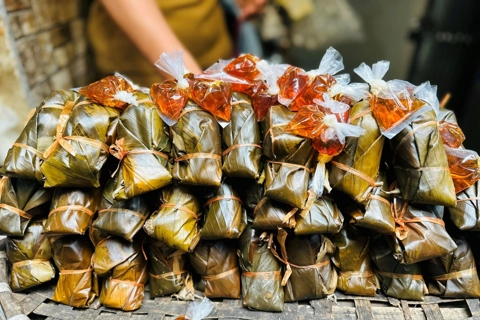Statue of King An Duong Vuong: A National Treasure with many rare features
The 19th-century statue revered at the Co Loa Special National Relic has many never-before-seen unique cultural, historical, and art values.
The statue of King An Duong Vuong, who ruled the kingdom of Au Lac (current-day Vietnam) from 257 to 207 BC, has been recognized as a national treasure.
The statue from the 19th century, which is revered at Co Loa Special National Relic, has many never-before-seen unique values of culture, history, and art. Local people unearthed an underground copper warehouse while restoring the Thuong temple at the Co Loa relic site.
It's believed that it was the royal copper storehouse, so the statue of King An Duong Vuong was cast in the found copper to worship at the temple. The casting of the statue was completed in 1897.
The statue of King An Duong Vuong is built of copper alloy using a wax mold casting technique (beeswax). It is seated on a solid cylindrical pedestal, holding a royal tablet in both hands with an air of calm dignity and majesty.
| A palanquin procession at Co Loa traditional festival. Photo: VNA |
The king wears a binh thien crown with the motif "two dragons adoring the sun." He is dressed in a long-sleeved, high-collar robe. The shoes that the figure of King An Duong Vuong puts on are decorated with blooming daisies.
The long robe’s decorative patterns are positioned symmetrically, including two dragons flanking the sun, a flying dragon, clouds, moon, stars, dragons, phoenixes, peacocks, plants, flowers, water waves, and other sacred symbols.
An inscription that reads: “Statue of King An Duong Vuong, cast on May 16, 1897, year of Rooster, weighs 255 kg” are carved and inlaid with gold on the statue.
| A statue of King An Duong Vuong has been recognized as National Treasure. Photo courtesy of Co Loa management board |
According to Hoang Cong Huy, Deputy Head of the Management Board of Co Loa relic site, the statue is an artifact displaying the 19th-century statue casting technique. It indicates the period’s fine arts with its distinctive decorative patterns.
In terms of historical value, the statue is the embodiment of the king who founded the Au Lac kingdom (the third century BC), settled the capital in Co Loa, led his subject in building a solid citadel, fought the enemy, and developed the production, especially a ruler with many achievements in the military art, wet rice farming, and bronze casting technique.
His statue is tied culturally to the Co Loa temple festival, illustrating the Vietnamese people’s tradition of "drinking water, remembering the source".
Besides, the statue is the pinnacle of traditional Vietnamese bronze casting techniques and fine arts. It is unusual for statues of kings to be cast sitting on a pedestal instead of a throne.
“The statue of King An Duong Vuong, worshipped in a sacred temple like Thuong Temple, deserves to be honored and preserved," Huy said.
Some details on the statue. Photo courtesy of Co Loa management board |














